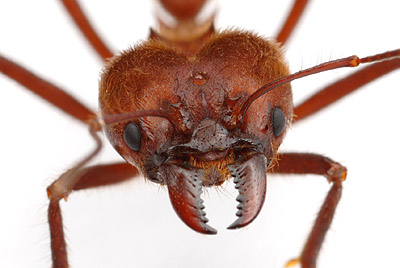
Another year passes. The economy is in the toilet. Violence spreads in the middle east. In these trying times, one question must weigh on the minds of concerned citizens: "What's happening in world of ant science?"
Of course. Here are the myrmecological highlights of 2008:
- The Demise of the Standard Ant. That is the title of a review by Juergen Heinze, but the idea that our basic conception of how ant colonies work is overly simplistic receives plenty of additional support from the research community.  For instance, Smith et al document the complexity of caste determination in Pogonomyrmex badius, while Schwander & Keller find likewise in P. rugosus. Meanwhile, Dobata et al show some supposed queens of Pristomyrmex punctata are actually parasites, and Hughes et al find parasitic patrilines among the attines.
- The Eureka Ant. A potential sister lineage to all living ants is discovered when Christian Rabeling and Manfred Verhaagh find Martialis heureka wandering about in Amazonian leaf litter near Manaus, Brazil. We gain a subfamily, Martialinae, and a great deal new to ponder about ant evolution.
- Ant Genomes. The Howard Hughes Medical Institute announces the funding of not one, but three ant genomes. While we won't see the assembled data for a good while yet, the genomes are certain to become a gold mine for many different areas of myrmecology. The announcement comes on the heels of Tsutsui et al's study on the evolution of genome size in ants.
- Elephants and giraffes are a pivotal part of Africa's famed ant-acacia mutualisms. Palmer et al experimentally removed large mammals from the system to find that the ant-acacia relationship broke down.
- Attine fungus-growing ants have a big year, with Schultz & Brady producing a detailed phylogeny of the attini, Bacci et al publishing a phylogeny of the leafcutting genus Atta, Mueller et al showing that some of the microbes in the system are not as co-evolved as had been thought, and Hughes et al documenting an abrupt shift in anti-microbial gland size in the leaf-cutting attine genera.
- Parasitic nematodes turn their ant hosts into bird-attracting berries so that they can spread to new ants via tasty bird poop. This, according to work by Yanoviak et al.
- Lasius neglectus' transition to invasiveness receives thorough documentation in a multi-disciplinary study headed by Syliva Cremer. The team concludes that pre-existing traits may have combined with human activity to assist an escape from parasites. A new pest is born.
- The ant evolutionary tree receives a boost as systematists produce species-level histories of the genera Pheidole, Atta, Lasius, Odontomachus, and Linepithema.
- Suicidal Forelius workers provide a stark example of altruism when they regularly close themselves out of the nest in the process of sealing it from attackers. As recorded by Tofilski et al.
- Treehoppers in trouble call ants. According to Morales et al, when hoppers get in trouble with lady beetles they issue audio signals. These attract ants that chase off the carnivorous coccinellids.
- GP-9 demystified. The enigmatic gp-9 was the first gene to be associated with social behavior in ants, marking the difference between single and multiple queen colonies of the fire ant Solenopsis invicta. A study by Wang et al showed that the gp-9 locus might not directly cause the difference itself; instead, it primarily affects gene expression at a small number of other loci, many associated with chemical communication. If you're wondering what the future holds for myrmecology, pay attention. These sorts of genomic studies will become much more common as researchers begin to dissect the links between genetics and social behavior.
Plenty else went down in 2008.  Ant Course continued its successful run in Venezuela.  NOVA filmed a special on E. O. Wilson. The North American section of IUSSI met in Puerto Rico, while the European section met in Brussells.  Harvard's Museum of Comparative Zoology celebrated their ant collection's centennial with a motley crew of myrmecologists. Bert Hoelldobler and E. O. Wilson published The Superorganism.
On the web, antweb.org continued to expand its global reach, adding faunas for Serbia, Kenya, Micronesia, the Philippines, and others. The nascent Encyclopedia of Life choose ants as one of their first focal groups. Myrmecological News stepped up efforts in 2008 under the direction of Birgit Schlick-Steiner, Herbert Zettel, and Florian Steiner, going online and petitioning for inclusion in the Web of Science.
Here's hoping that 2009 brings a similar trove of anty goodness.

I'm not sure I can stand the excitement! :)
Yeah, I know. We have to keep the lab door locked just to keep the crowds out.
Photos./Videos of the madness. ;)